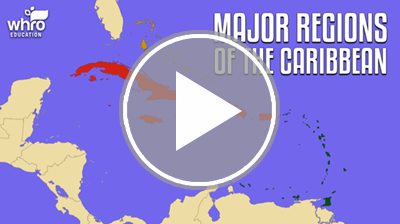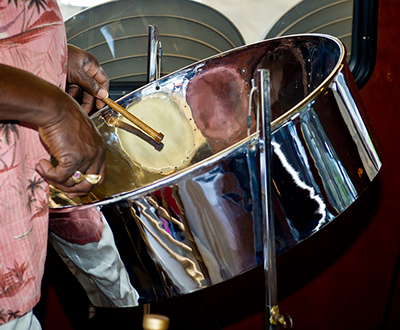The Caribbean
Major Regions of the Caribbean

The Caribbean is located southeast of the United States and the Gulf of Mexico, east of Central America, and north of South America. This region, also called the West Indies, contains many countries and dependent territories. In this interactivity, you will explore the major regions and countries of the Caribbean. Click the player to begin.
View a printable version of this interactivity or an ADA compliant transcript.
Cultural Influences of the Caribbean

The Caribbean has indigenous, African, and European influences. These influences have blended together in different ways on different islands. This has led to a variety of unique cultures in the region. In this interactivity, you will explore the cultural influences of the Caribbean. Click the player to begin.
View a printable version of this interactivity or an ADA compliant transcript.
Calypso, Steel Drums, and Reggae

Calypso is a musical genre that blends African and French influences. Its roots can be traced back to a time when African slaves were prohibited from speaking to one another. Instead, they communicated through song. Calypso music evolved over time. In the nineteenth century, calypso songs were a common way for islanders to spread news. In the early-twentieth century, calypso music spread beyond the Caribbean. It influenced many genres like soul, funk, and reggae.
Steel drums, sometimes called steelpans, also originated in Trinidad and Tobago. This percussion instrument had simple beginnings. It involved hitting frying pans, hubcaps, and oil drums with bamboo sticks. Today, steel drums are made from large industrial drum barrels that are musically pitched.
Reggae music emerged in Jamaica during the 1960s. Calypso and Jamaican folk music, as well as American jazz, and rhythm and blues influenced reggae music. This musical genre incorporates a slightly off-beat rhythmic bass and drums. Reggae music achieved international popularity. It continues to influence musicians around the world.
Economic Characteristics of the Caribbean

Beach resort in the Dominican Republic
Tourism is a major industry throughout the Caribbean. On some islands, tourism is the single largest contributor to the economy. For example, in the Bahamas, the tourism industry accounts for more than 50% of the nation’s GDP. On other islands, tourism makes up a significant part of the economy, along with agriculture, mining, and manufacturing.
Individual economies of the Caribbean vary, depending on the availability of natural resources. Cuba, Jamaica, and the Dominican Republic have large areas of fertile soil used to grow cash crops like sugar cane. Trinidad and Tobago has access to oil and natural gas. This has allowed the country to develop a large energy industry. Jamaica’s main export is the mineral bauxite, which is used to produce aluminum. Precious metals are important exports in the Dominican Republic, which contains the second-largest gold mine in the world.

Impoverished neighborhood in Haiti
Many areas of the Caribbean face challenges of unequal income distribution. Poverty and lack of economic opportunity have increased out-migration from the region. Many people emigrate from the Caribbean to places like the United States, Canada, and Europe in search of work. The Caribbean is also vulnerable to natural disasters like earthquakes and hurricanes. These natural disasters can severely damage industry and infrastructure.
The Caribbean Review

 Now that you have learned about the major regions, cultural influences, and economic characteristics of the Caribbean, review your knowledge in this interactivity. Click the player to get started.
Now that you have learned about the major regions, cultural influences, and economic characteristics of the Caribbean, review your knowledge in this interactivity. Click the player to get started.






